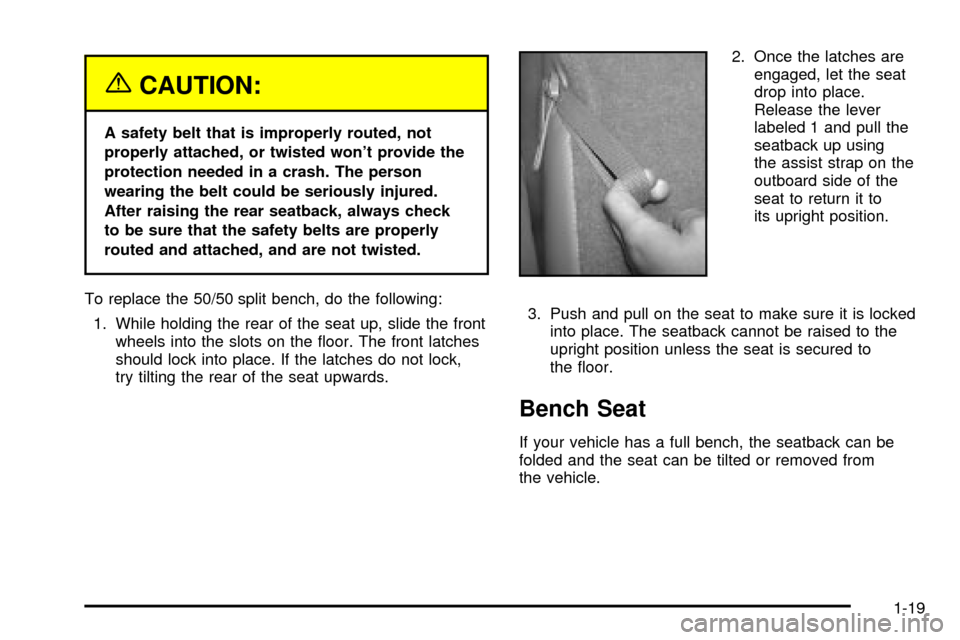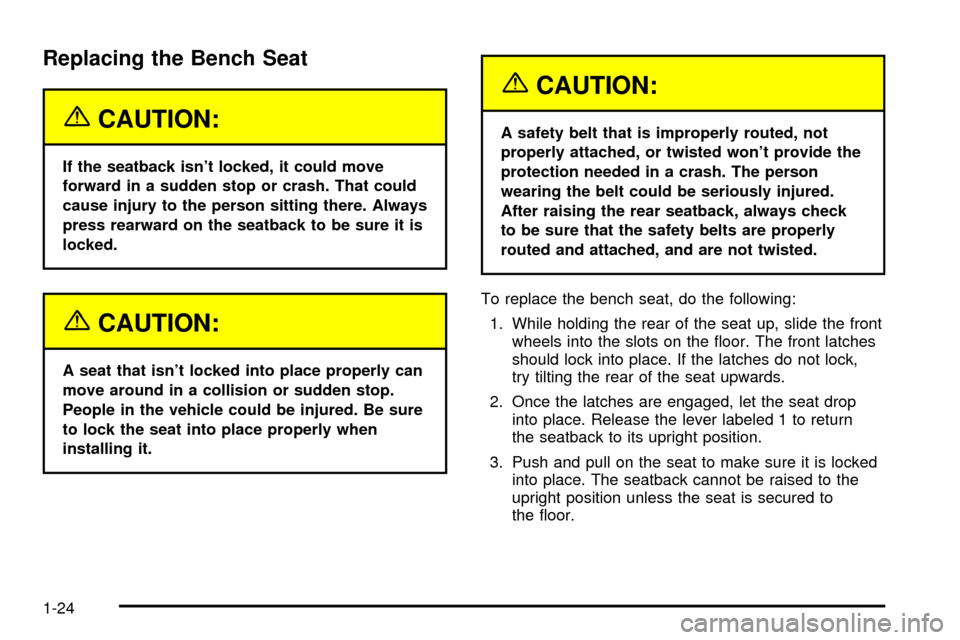Page 7 of 486

Front Seats......................................................1-3
Power Seats..................................................1-3
Power Lumbar...............................................1-4
Heated Seats.................................................1-5
Reclining Seatbacks........................................1-6
Head Restraints.............................................1-7
Rear Seats.......................................................1-8
Rear Seat Operation.......................................1-8
Heated Seats...............................................1-10
60/40 Split Bench Seat..................................1-10
50/50 Split Bench Seat..................................1-13
Bench Seat..................................................1-19
Bucket Seats...............................................1-25
Safety Belts...................................................1-28
Safety Belts: They Are for Everyone................1-28
Questions and Answers About Safety Belts......1-32
How to Wear Safety Belts Properly.................1-33
Driver Position..............................................1-34
Safety Belt Use During Pregnancy..................1-41
Right Front Passenger Position.......................1-42
Center Passenger Position.............................1-42Rear Seat Passengers..................................1-44
Rear Safety Belt Comfort Guides for Children
and Small Adults.......................................1-47
Safety Belt Extender.....................................1-50
Child Restraints.............................................1-51
Older Children..............................................1-51
Infants and Young Children............................1-53
Child Restraint Systems.................................1-57
Where to Put the Restraint.............................1-60
Top Strap....................................................1-61
Top Strap Anchor Location.............................1-63
Lower Anchorages and Top Tethers for
Children (LATCH System)...........................1-65
Securing a Child Restraint Designed for the
LATCH System.........................................1-67
Securing a Child Restraint in a Rear Outside
Seat Position............................................1-67
Securing a Child Restraint in a Center Rear
Seat Position............................................1-70
Securing a Child Restraint in the Right Front
Seat Position............................................1-72
Section 1 Seats and Restraint Systems
1-1
Page 19 of 486
To return the seat to the upright position, do the
following:
1. On Escalade ESV models, lift the load ¯oor panels
and latch them into the seatback.
2. Lift the seatback up and push it rearward all the
way.
3. Lower the seat cushion until it latches into position.
4. Pull forward on the seatback and up on the seat
cushion to make sure the seat is securely in
place.
5. On Escalade models, return the head restraints to
the upright position.
6. Check to see that the safety belt buckles on the
driver's side seat are accessible to the outboard
and center occupants and are not under the
seat cushions.50/50 Split Bench Seat
If your vehicle has a 50/50 split bench, the seatback(s)
can be folded and the entire seat(s) tilted or removed
from the vehicle.
Folding the Seatbacks
To fold the seatbacks, do the following:
1. Pull up on the release
lever, labeled 1,
located on the rear of
the seatback, and
push the seatback
forward.
1-13
Page 25 of 486

{CAUTION:
A safety belt that is improperly routed, not
properly attached, or twisted won't provide the
protection needed in a crash. The person
wearing the belt could be seriously injured.
After raising the rear seatback, always check
to be sure that the safety belts are properly
routed and attached, and are not twisted.
To replace the 50/50 split bench, do the following:
1. While holding the rear of the seat up, slide the front
wheels into the slots on the ¯oor. The front latches
should lock into place. If the latches do not lock,
try tilting the rear of the seat upwards.2. Once the latches are
engaged, let the seat
drop into place.
Release the lever
labeled 1 and pull the
seatback up using
the assist strap on the
outboard side of the
seat to return it to
its upright position.
3. Push and pull on the seat to make sure it is locked
into place. The seatback cannot be raised to the
upright position unless the seat is secured to
the ¯oor.
Bench Seat
If your vehicle has a full bench, the seatback can be
folded and the seat can be tilted or removed from
the vehicle.
1-19
Page 30 of 486

Replacing the Bench Seat
{CAUTION:
If the seatback isn't locked, it could move
forward in a sudden stop or crash. That could
cause injury to the person sitting there. Always
press rearward on the seatback to be sure it is
locked.
{CAUTION:
A seat that isn't locked into place properly can
move around in a collision or sudden stop.
People in the vehicle could be injured. Be sure
to lock the seat into place properly when
installing it.
{CAUTION:
A safety belt that is improperly routed, not
properly attached, or twisted won't provide the
protection needed in a crash. The person
wearing the belt could be seriously injured.
After raising the rear seatback, always check
to be sure that the safety belts are properly
routed and attached, and are not twisted.
To replace the bench seat, do the following:
1. While holding the rear of the seat up, slide the front
wheels into the slots on the ¯oor. The front latches
should lock into place. If the latches do not lock,
try tilting the rear of the seat upwards.
2. Once the latches are engaged, let the seat drop
into place. Release the lever labeled 1 to return
the seatback to its upright position.
3. Push and pull on the seat to make sure it is locked
into place. The seatback cannot be raised to the
upright position unless the seat is secured to
the ¯oor.
1-24
Page 33 of 486
To create a load ¯oor, do the following:
1. Release the panels from the seatbacks by pushing
forward on the latches.
2. Then fold the panels back to cover the rear seat
footwell area.Returning the Seatbacks to an Upright
Position
{CAUTION:
If the seatback isn't locked, it could move
forward in a sudden stop or crash. That could
cause injury to the person sitting there. Always
press rearward on the seatback to be sure it is
locked.
To return the seatbacks to the upright position, do the
following:
1. On Escalade ESV models, lift the load ¯oor panels
and latch them into the seatback.
2. Lift the seatback up and push it rearward all the
way. On Escalade ESV models, move the headrest
to the seatback.
3. Lower the seat cushion until it latches into position.
4. Pull forward on the seatback and up on the seat
cushion to make sure the seat is securely in place.
5. On Escalade models, return the headrests to the
upright position.
1-27
Page 40 of 486
Driver Position
This part describes the driver's restraint system.
Lap-Shoulder Belt
The driver has a lap-shoulder belt. Here's how to wear it
properly.
1. Close and lock the door.
2. Adjust the seat so you can sit up straight. To see
how, see ªSeatsº in the Index.
3. Pick up the latch plate and pull the belt across you.
Don't let it get twisted.
4. Push the latch plate into the buckle until it clicks.
Pull up on the latch plate to make sure it is secure.
If the belt isn't long enough, see
Safety Belt
Extender on page 1-50.
Make sure the release button on the buckle is
positioned so you would be able to unbuckle the
safety belt quickly if you ever had to.
1-34
Page 51 of 486
2. Push the latch plate into the buckle until it clicks.
Pull up on the latch plate to make sure it is secure.
When the shoulder belt is pulled out all the way,
it will lock. If it does, let it go back all the way and
start again.
If the belt is not long enough, see
Safety Belt
Extender on page 1-50.
Make sure the release button on the buckle is
positioned so you would be able to unbuckle the
safety belt quickly if you ever had to.
3. To make the lap part tight, pull down on the buckle
end of the belt as you pull up on the shoulder part.
1-45
Page 60 of 486
Every time infants and young children ride in vehicles,
they should have the protection provided by appropriate
restraints. Young children should not use the vehicle's
adult safety belts alone, unless there is no other choice.
Instead, they need to use a child restraint.
{CAUTION:
People should never hold a baby in their arms
while riding in a vehicle. A baby doesn't weigh
much -- until a crash. During a crash a baby
will become so heavy it is not possible to hold
it. For example, in a crash at only 25 mph
(40 km/h), a 12-lb. (5.5 kg) baby will suddenly
become a 240-lb. (110 kg) force on a person's
arms. A baby should be secured in an
appropriate restraint.
1-54